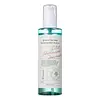What's inside
What's inside
 Key Ingredients
Key Ingredients

 Benefits
Benefits

 Concerns
Concerns

 Ingredients Side-by-side
Ingredients Side-by-side

Water
Skin ConditioningSodium C14-16 Olefin Sulfonate
CleansingGlycerin
HumectantAcrylates Copolymer
Butylene Glycol
HumectantPropanediol
SolventCoco-Betaine
CleansingRosmarinus Officinalis Leaf Extract
AntimicrobialTromethamine
BufferingTetradecene
EmollientPotassium Benzoate
PreservativeSalicylic Acid
MaskingCitric Acid
BufferingHexadecene
SolventLauryl Hydroxysultaine
CleansingCoco-Glucoside
CleansingPogostemon Cablin Leaf Oil
MaskingDecyl Glucoside
CleansingSorbitol
HumectantPolyquaternium-10
Rosmarinus Officinalis Leaf Oil
MaskingPanthenol
Skin ConditioningSodium Chloride
MaskingDisodium EDTA
Melia Azadirachta Leaf Extract
Skin ConditioningArtemisia Vulgaris Oil
Perfuming1,2-Hexanediol
Skin ConditioningMelia Azadirachta Flower Extract
Skin ConditioningBrassica Oleracea Capitata Leaf Extract
Skin ConditioningBrassica Oleracea Acephala Leaf Extract
HumectantArtemisia Princeps Leaf Water
MaskingHibiscus Esculentus Fruit Extract
Skin ConditioningHyaluronic Acid
HumectantHydrolyzed Hyaluronic Acid
HumectantSodium Hyaluronate
HumectantApium Graveolens Extract
Skin ConditioningAsparagus Officinalis Extract
Skin ConditioningSpinacia Oleracea Leaf Extract
Skin ConditioningBrassica Oleracea Italica Extract
AstringentCucumis Sativus Extract
Skin ConditioningLactuca Scariola Sativa Leaf Extract
Skin ConditioningAllantoin
Skin ConditioningWater, Sodium C14-16 Olefin Sulfonate, Glycerin, Acrylates Copolymer, Butylene Glycol, Propanediol, Coco-Betaine, Rosmarinus Officinalis Leaf Extract, Tromethamine, Tetradecene, Potassium Benzoate, Salicylic Acid, Citric Acid, Hexadecene, Lauryl Hydroxysultaine, Coco-Glucoside, Pogostemon Cablin Leaf Oil, Decyl Glucoside, Sorbitol, Polyquaternium-10, Rosmarinus Officinalis Leaf Oil, Panthenol, Sodium Chloride, Disodium EDTA, Melia Azadirachta Leaf Extract, Artemisia Vulgaris Oil, 1,2-Hexanediol, Melia Azadirachta Flower Extract, Brassica Oleracea Capitata Leaf Extract, Brassica Oleracea Acephala Leaf Extract, Artemisia Princeps Leaf Water, Hibiscus Esculentus Fruit Extract, Hyaluronic Acid, Hydrolyzed Hyaluronic Acid, Sodium Hyaluronate, Apium Graveolens Extract, Asparagus Officinalis Extract, Spinacia Oleracea Leaf Extract, Brassica Oleracea Italica Extract, Cucumis Sativus Extract, Lactuca Scariola Sativa Leaf Extract, Allantoin
Water
Skin ConditioningDecyl Glucoside
CleansingSodium Cocoyl Glutamate
CleansingChenopodium Quinoa Seed Extract
Skin ConditioningGlycerin
HumectantSodium Lauroyl Glutamate
Betaine
HumectantGlycine Soja Oil
EmollientMelaleuca Alternifolia Leaf Extract
PerfumingChlorphenesin
AntimicrobialHydroxyacetophenone
AntioxidantEthylhexylglycerin
Skin ConditioningCamellia Sinensis Leaf Extract
AntimicrobialHumulus Lupulus Extract
AntimicrobialOcimum Tenuiflorum Extract
Skin ConditioningCentella Asiatica Extract
CleansingCalendula Officinalis Flower Extract
MaskingPrunus Amygdalus Dulcis Fruit Extract
Skin ConditioningCitric Acid
BufferingGeranium Maculatum Oil
MaskingAllantoin
Skin ConditioningWater, Decyl Glucoside, Sodium Cocoyl Glutamate, Chenopodium Quinoa Seed Extract, Glycerin, Sodium Lauroyl Glutamate, Betaine, Glycine Soja Oil, Melaleuca Alternifolia Leaf Extract, Chlorphenesin, Hydroxyacetophenone, Ethylhexylglycerin, Camellia Sinensis Leaf Extract, Humulus Lupulus Extract, Ocimum Tenuiflorum Extract, Centella Asiatica Extract, Calendula Officinalis Flower Extract, Prunus Amygdalus Dulcis Fruit Extract, Citric Acid, Geranium Maculatum Oil, Allantoin
 Reviews
Reviews

Ingredients Explained
These ingredients are found in both products.
Ingredients higher up in an ingredient list are typically present in a larger amount.
Allantoin is a soothing ingredient known for its protective and moisturizingg properties. Because of this, it is often added to products with strong active ingredients.
Studies show higher concentrations of this ingredient can promote wound healing.
Though it can be derived from the comfrey plant, allantoin is produced synthetically for cosmetic products to ensure purity.
Learn more about AllantoinCitric Acid is an alpha hydroxy acid (AHA) naturally found in citrus fruits like oranges, lemons, and limes.
Like other AHAs, citric acid can exfoliate skin by breaking down the bonds that hold dead skin cells together. This helps reveal smoother and brighter skin underneath.
However, this exfoliating effect only happens at high concentrations (20%) which can be hard to find in cosmetic products.
Due to this, citric acid is usually included in small amounts as a pH adjuster. This helps keep products slightly more acidic and compatible with skin's natural pH.
In skincare formulas, citric acid can:
While it can provide some skin benefits, research shows lactic acid and glycolic acid are generally more effective and less irritating exfoliants.
Most citric acid used in skincare today is made by fermenting sugars (usually from molasses). This synthetic version is identical to the natural citrus form but easier to stabilize and use in formulations.
Read more about some other popular AHA's here:
Learn more about Citric AcidDecyl Glucoside is a glucose-based surfactant and emulsion stabilizer. It is created by reacting glucose with the fatty acids from plants.
Surfactants help clean the skin by trapping oil, sebum, and dirt to be washed away. As an emulsion stabilizer, it stabilizes the ingredients in a product by preventing them from separating.
This ingredient is biodegradable and non-toxic. This ingredient is commonly found in baby shampoos.
Decyl Glucoside is sometimes used to stabilize the UV filter Tinosorb.
Learn more about Decyl GlucosideGlycerin is already naturally found in your skin. It helps moisturize and protect your skin.
A study from 2016 found glycerin to be more effective as a humectant than AHAs and hyaluronic acid.
As a humectant, it helps the skin stay hydrated by pulling moisture to your skin. The low molecular weight of glycerin allows it to pull moisture into the deeper layers of your skin.
Hydrated skin improves your skin barrier; Your skin barrier helps protect against irritants and bacteria.
Glycerin has also been found to have antimicrobial and antiviral properties. Due to these properties, glycerin is often used in wound and burn treatments.
In cosmetics, glycerin is usually derived from plants such as soybean or palm. However, it can also be sourced from animals, such as tallow or animal fat.
This ingredient is organic, colorless, odorless, and non-toxic.
Glycerin is the name for this ingredient in American English. British English uses Glycerol/Glycerine.
Learn more about GlycerinWater. It's the most common cosmetic ingredient of all. You'll usually see it at the top of ingredient lists, meaning that it makes up the largest part of the product.
So why is it so popular? Water most often acts as a solvent - this means that it helps dissolve other ingredients into the formulation.
You'll also recognize water as that liquid we all need to stay alive. If you see this, drink a glass of water. Stay hydrated!
Learn more about Water